Download Vmware Vcenter Server 5.5 Free Online
VMware vCenter server Apparatus half dozen.7 U1 (VCSA) is a VM running Photon OS, which is hardened and optimized VMware Linux distribution.
All future releases will just be available as VCSA which is the preferred deployment method of vCenter Server.
If you're running an older version of vCenter server on Windows, you can migrate to VCSA via a congenital-in migration tool. The migration procedure is quite piece of cake, simply today we'll focus only on clean installation and configuration of VCSA in a new environs.
Software Requirements:
- You must use ESXi host with version five.v and higher.
- The minimum hosts that can be connected every bit a role of the datacenter managed by VCSA 6.7 must be ESXi 6.0 and higher.
- You can cheque version compatibility with other VMware products run into the Production Interoperability Matrix.
Architecture:
- Recommended VMware architecture is now a vCenter server and Platform Service controller (PSC) within a single VM.
- The VCSA with embedded PSC requires the following hardware resources (deejay can be thin provisioned)
– Tiny (up to 10 hosts, 100 VMs) – two CPUs, 10 GB RAM
– Pocket-size (upward to 100 hosts, 1000 VMs) – 4 CPUs, xvi GB RAM.
– Medium (up to 400 hosts, 4000 VMs) – viii CPUs, 24 GB RAM.
– Large (up to 1000 hosts, x,000 VMs) – 16 CPUs, 32 GB RAM.
– X-Big (upward to 2000 hosts, 35,000 VMs) – 24 CPUs, 48 GB RAM
- Configure proper DNS with forward and opposite records. FQDN resolution should be in place when deploying vCenter Server.
- If you have firewall between vCenter and the residuum of infrastructure, a Required Ports for vCenter Server and PSC can be found here.
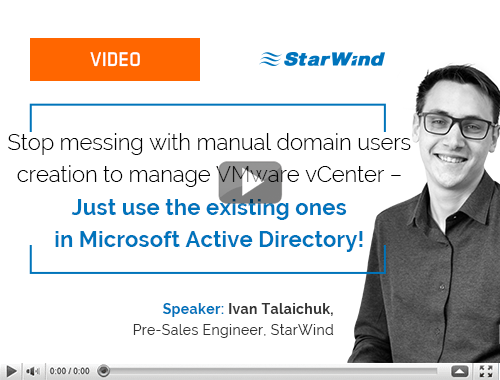
End all that hurting of adding new users manually in VMware vCenter
Learn from this video virtually:
- The advantages of calculation VCSA to Microsoft AD
- Requirements for joining VCSA to Microsoft AD domain
- Guidance on how to add VCSA to Microsoft AD
Costless of Charge. No Registration.
Installation Steps
vCenter 6.7 U1 Download
It is a big ISO file. In our case, the latest version is this i: "VMware-VCSA-all-six.7.0-10244745.iso"
Installing the appliance is a ii-stage procedure. The commencement phase will simply deploy a new appliance to the target vCenter Server or ESXi host. The 2d stage will finalize the setup of the deployed appliance.
First mount the ISO and navigate to the folder which corresponds to the Os you take on your direction workstation yous're trying to install from. Yous tin can use Windows, Linux or MAC to install VMware VCSA.
The folder is "vcsa-ui-installer" and inside you lot have 3 different folders. If yous're in Windows, simply chose the win32 binder. If you lot're on Linux, chose the "lin64" etc.
Then launch the installer.exe (case under Windows).
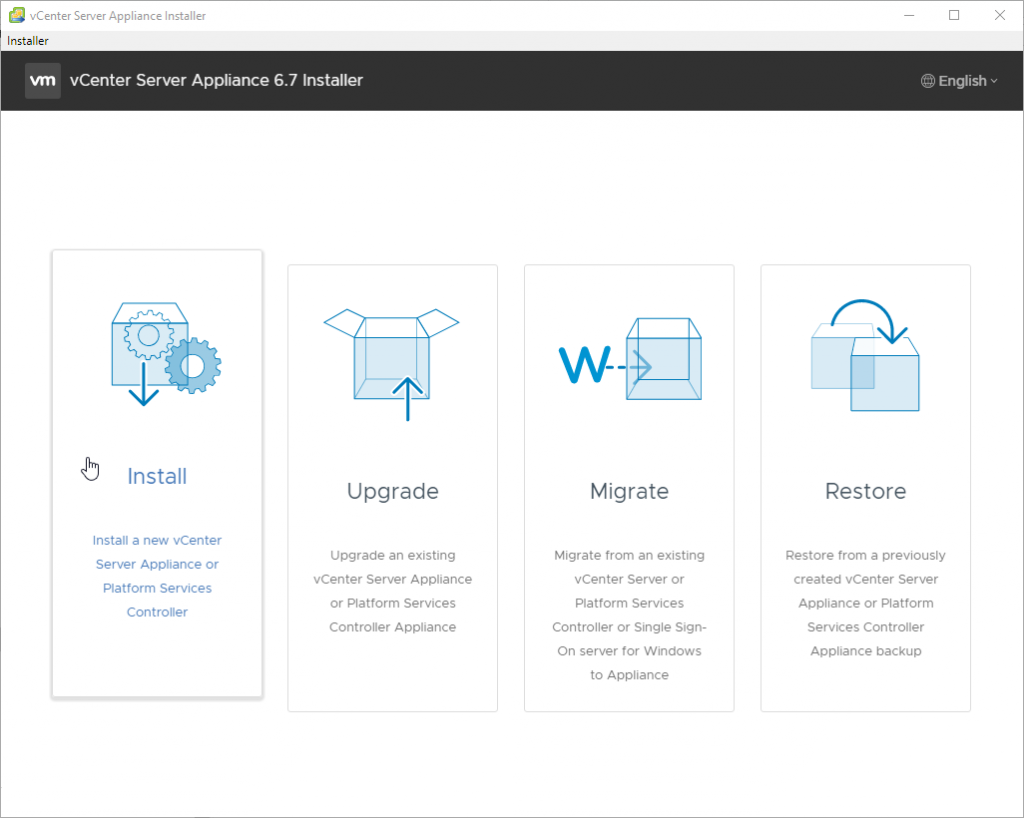
Install a New vCenter Server Appliance
As you can meet, other possibilities which the installer offers are Upgrade, Migrate or Restore. We'll do a Drift in ane of our future posts.
Side by side, you'll just follow the assistant which volition walks you through. Remember to configure your DNS prior to continuing and brand certain to bank check whether the resolution works.
Yous can test this with an "nslookup" control through a control line window.
Unless you really demand to split vCenter Server and PSC, go on the pre-selected option chosen "Embedded Platform Service Controller", which keeps both components together in a single VM. It greatly simplifies management, upgrades and patching.
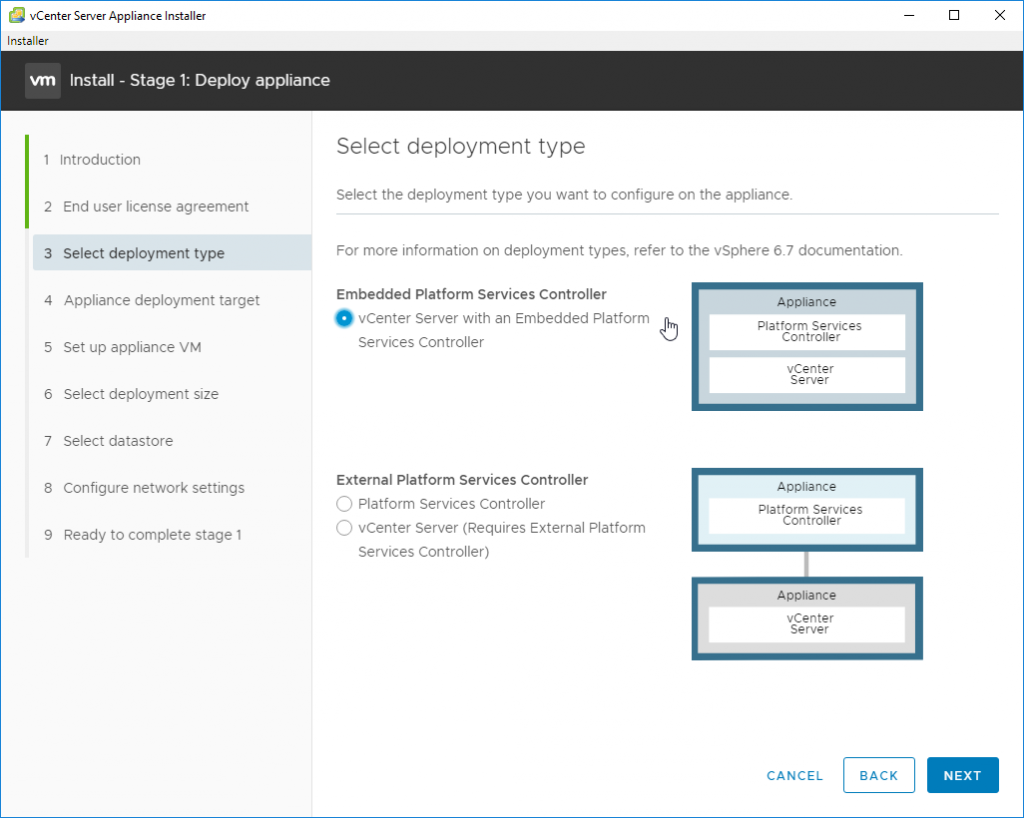
Apply Embedded vCenter and PSC ratio button selection
Adjacent screen invites united states of america to specify target for our deployment. It can be vCenter server or individual host. If y'all have individual host, just put an IP address of the individual host.
In my example I have small lab where I'k using vCenter server so I point to my current vCenter.
Enter the FQDN or IP address of the host, or vCenter upon which you wish to deploy the new VCSA. Enter the credentials of an authoritative or root user and click Next. The installer will validate admission, if prompted with an untrusted SSL document message click.
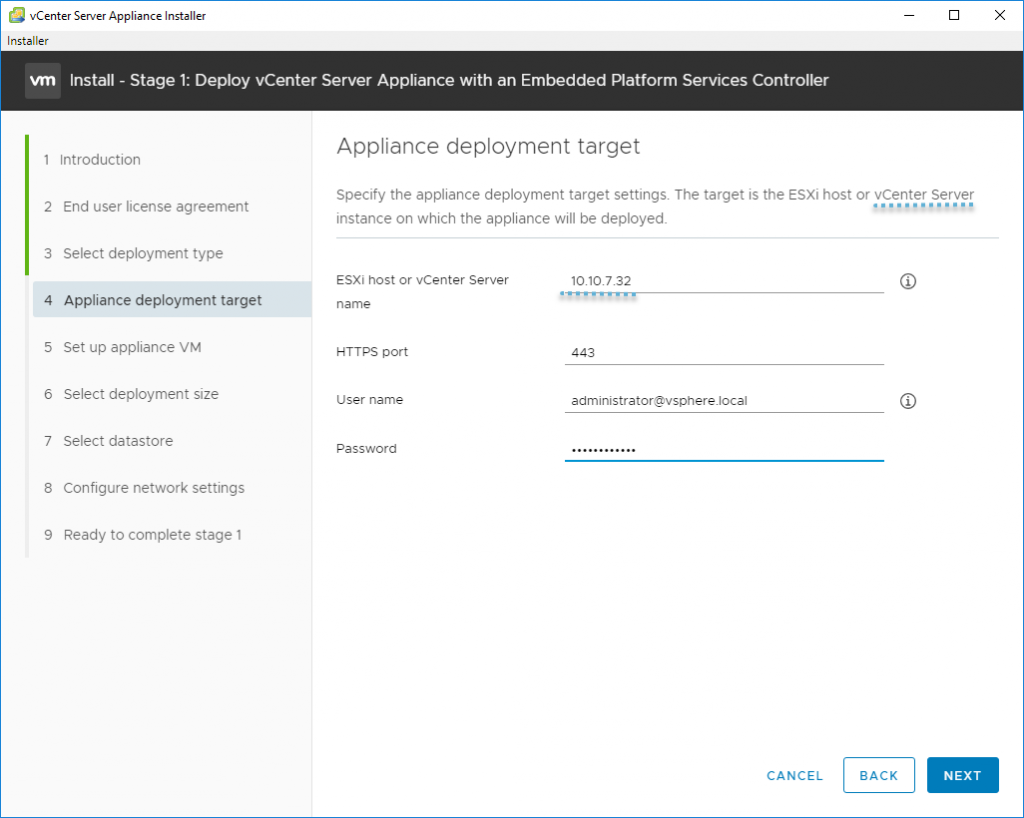
Specify deployment target
Click Next to continue.
After this, we'll proceed with the assistant and have a view of our datacenter. We must choose a location where this VM volition be registered and on which host/cluster.
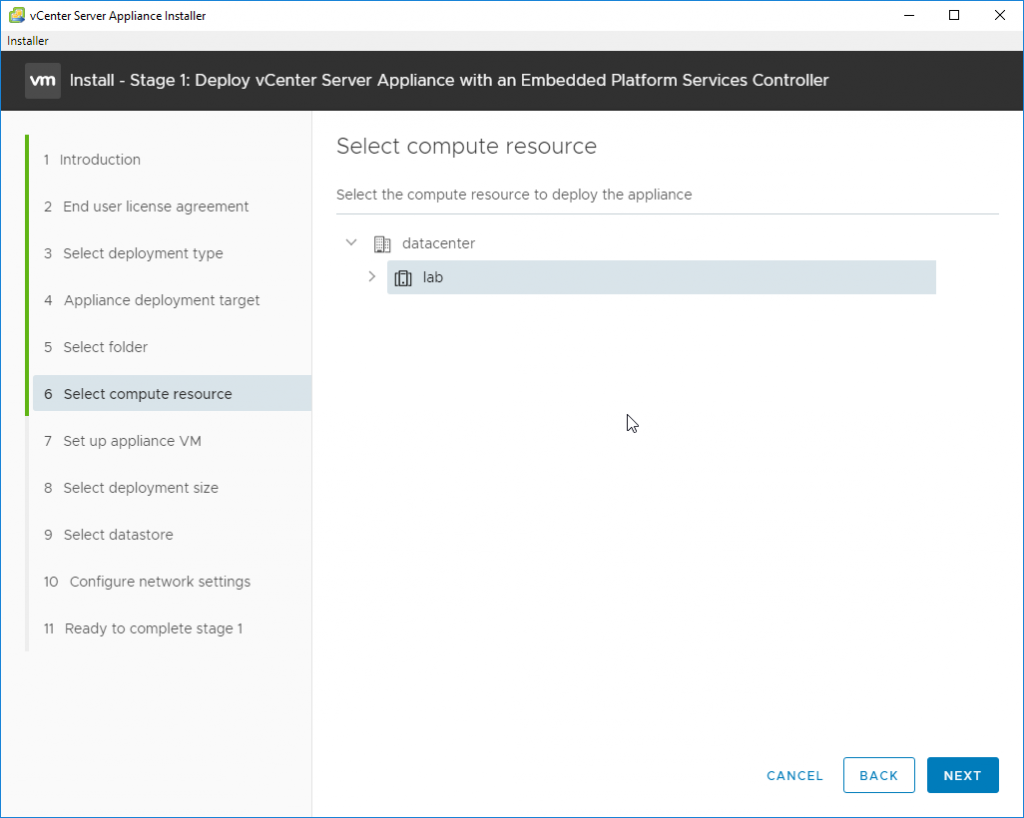
Select compute resource
Ensure that DRS is set up to manual for the cluster temporarily so that the VMs for the Source and Target do not get moved during the upgrade.
And then provide the VM proper noun and root countersign which must exist complex plenty and match. If not, the assistant won't let you lot to continue.
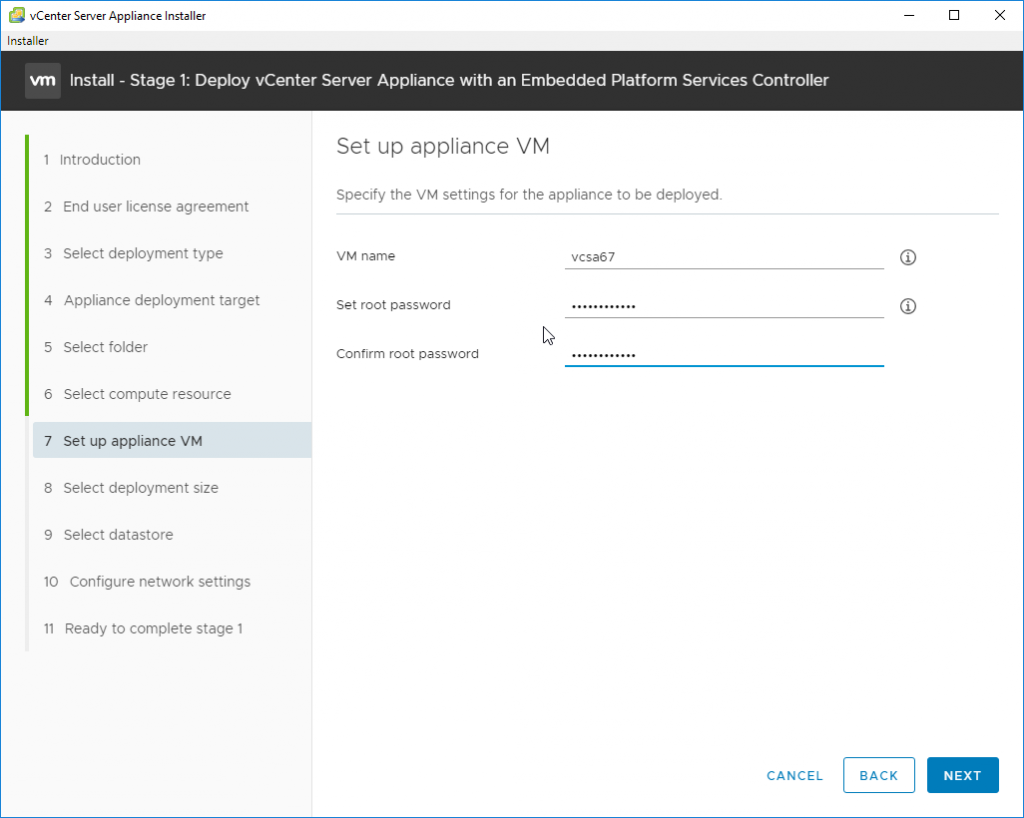
Provide VM name and root password
On the adjacent screen we'll chose a deployment size. We can cull between:
Tiny, Small, Medium, Big or X-Large. We can also increase the storage size of the VMDKs disks via the drib-downward card.
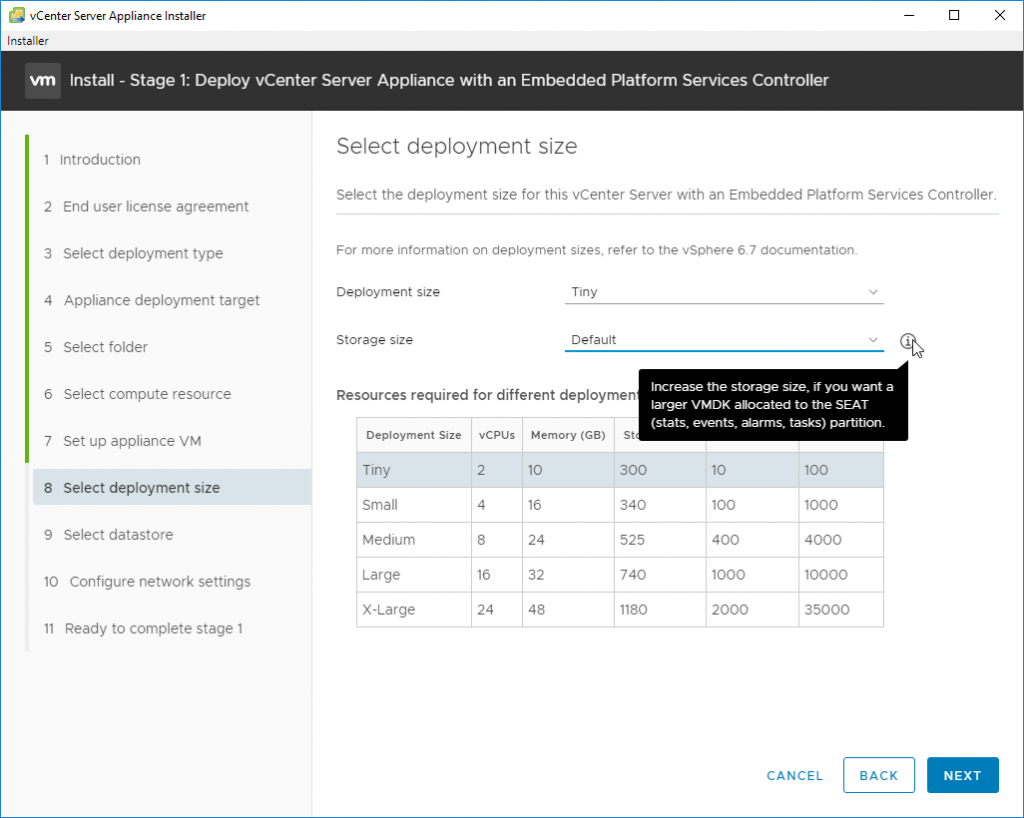
Cull storage size depending on your environment
And on the adjacent screen nosotros'll need to select a datastore location for our VMDKs, VM'south config files and other files will be stored.
Note that nosotros have an option to enable Call back disk mode, which allows the states to save some disk space.
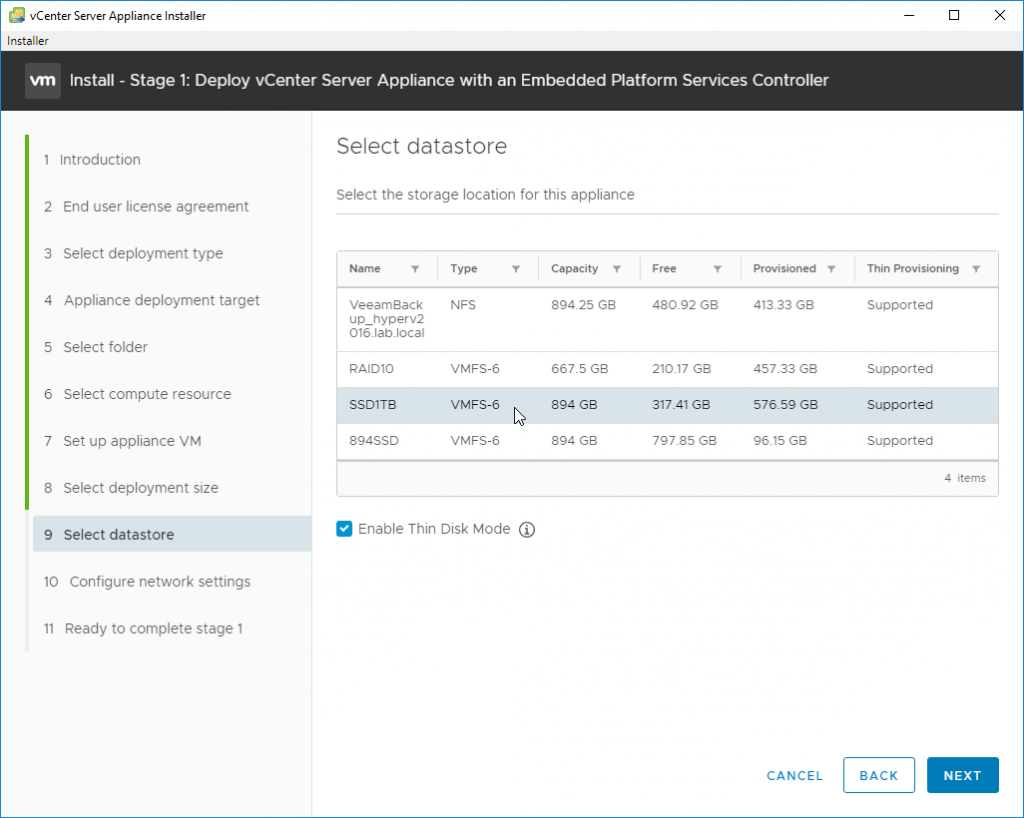
Select datastore where those VMDKs will be stored.
1 terminal step is to configure network settings. Make certain you enter the right values which depends on your environment.
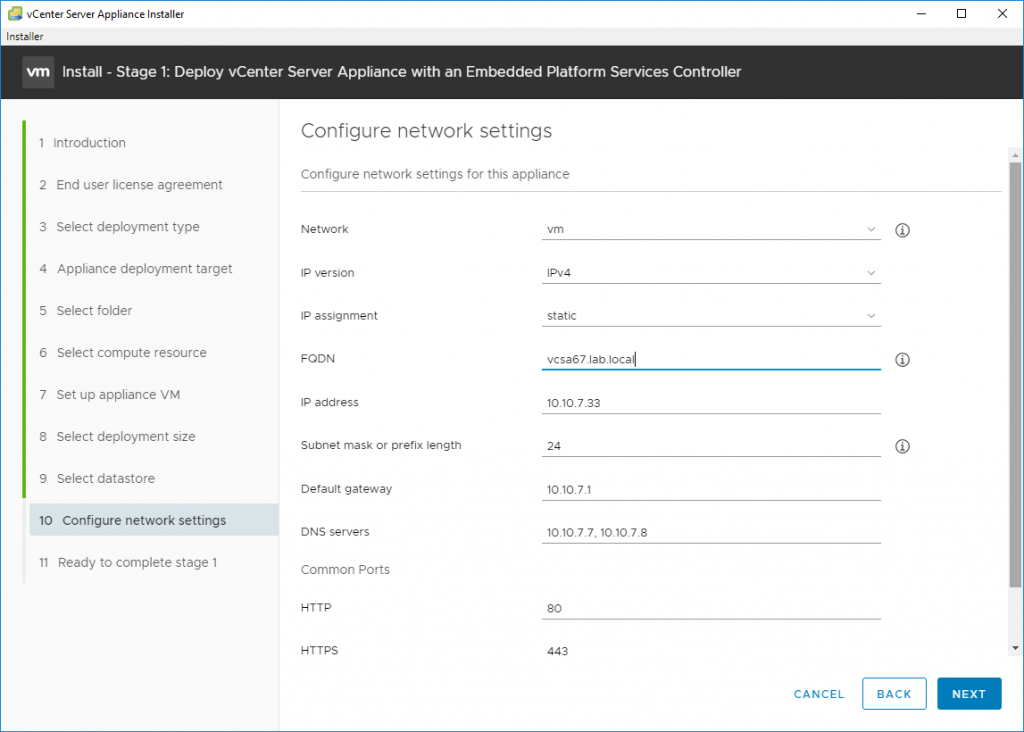
Configure network settings of your VCSA
After the recap screen, this closes the stage 1
You'll see the deployment process to continue.
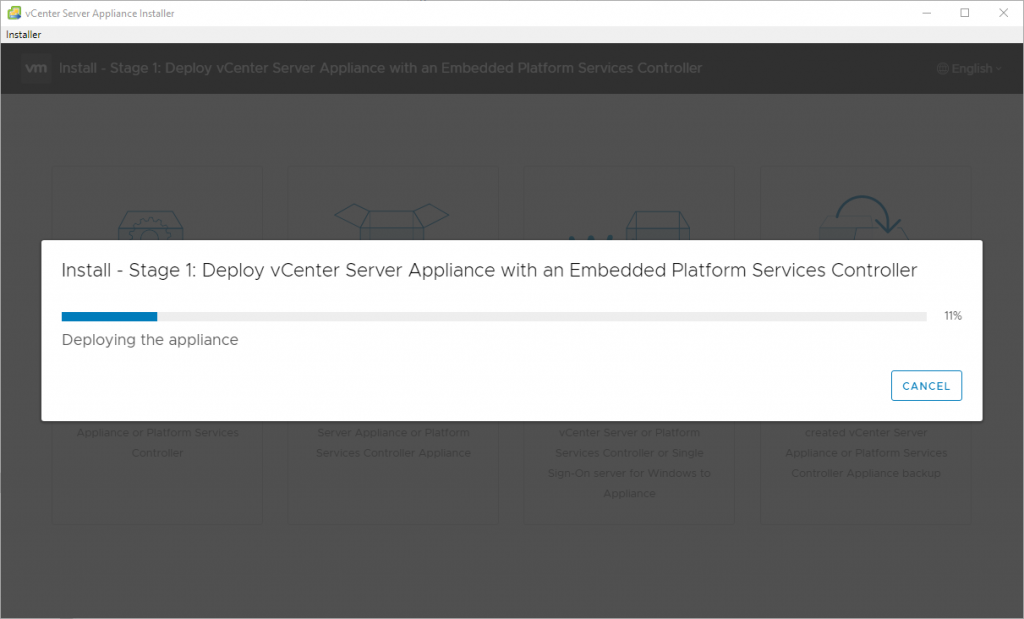
Phase 1 is deploying the VCSA appliance
And then y'all can click Continue for the phase 2 configuration.
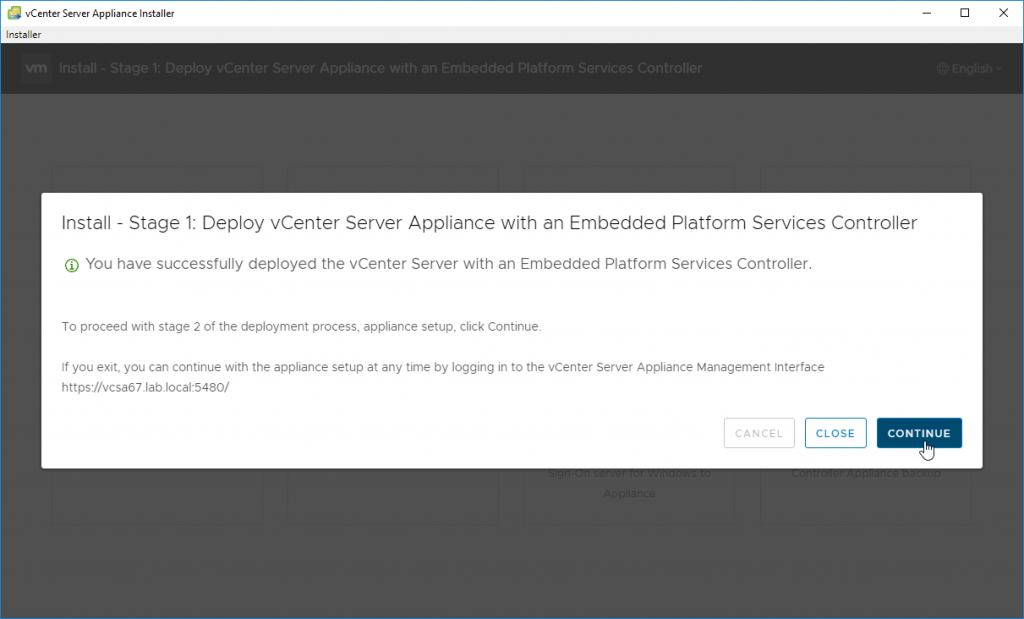
Continue with Stage two
Information technology will cheque the config and call back information before starting another assistant. Follow the assistant.
Yous'll have an option to enable SSH and chose Time Synchronization Method. While you can practise that during the configuration, there is also possibility to do that later when configuring and monitoring the VCSA appliance itself.
Side by side, we need to configure VMware SSO and Administrator's countersign. We are creating new SSO domain every bit information technology is a greenfield installation.
You can too cull to join existing SSO domain if you're installing another vCenter server inside the aforementioned installation.
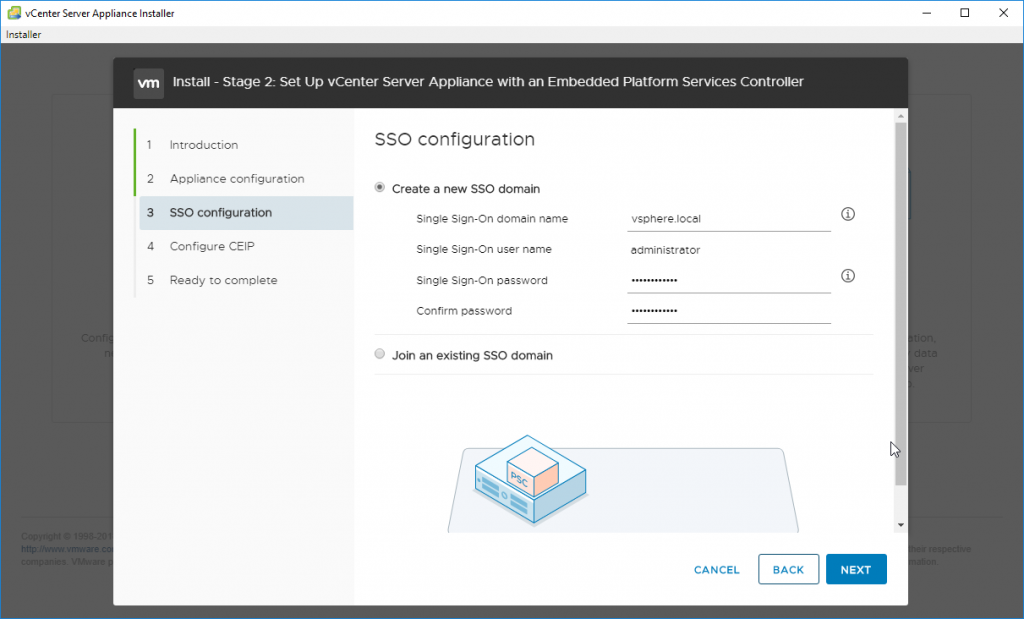
VMware SSO configuration
You tin can opt-in and join VMware customer experience improvement plan (CEIP) which helps VMware to improve its products and services, to fix problems, and to advise you on how best to deploy and utilize their products.
Nonetheless, VMware collects technical information nigh your system, but not much. The advantage of joining the CEIP is that when you ask for a support, VMware has much more insight from your installation than if you haven't checked that. They tin can see firmware/driver versions on host and also misconfigurations. This greatly helps in troubleshooting.
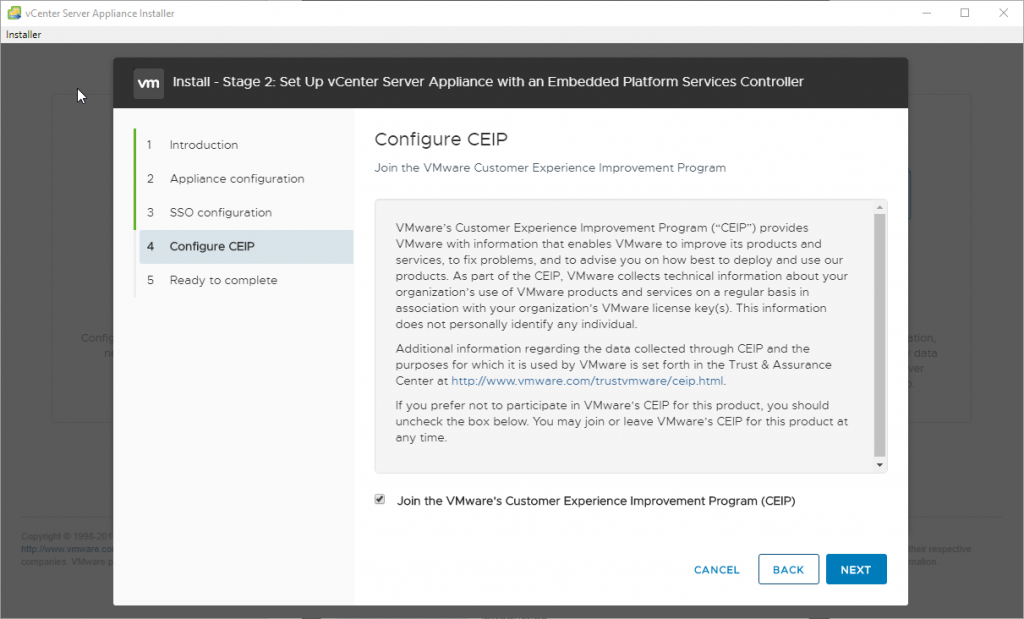
You tin can join VMware CEIP
And the final screen looks like this.
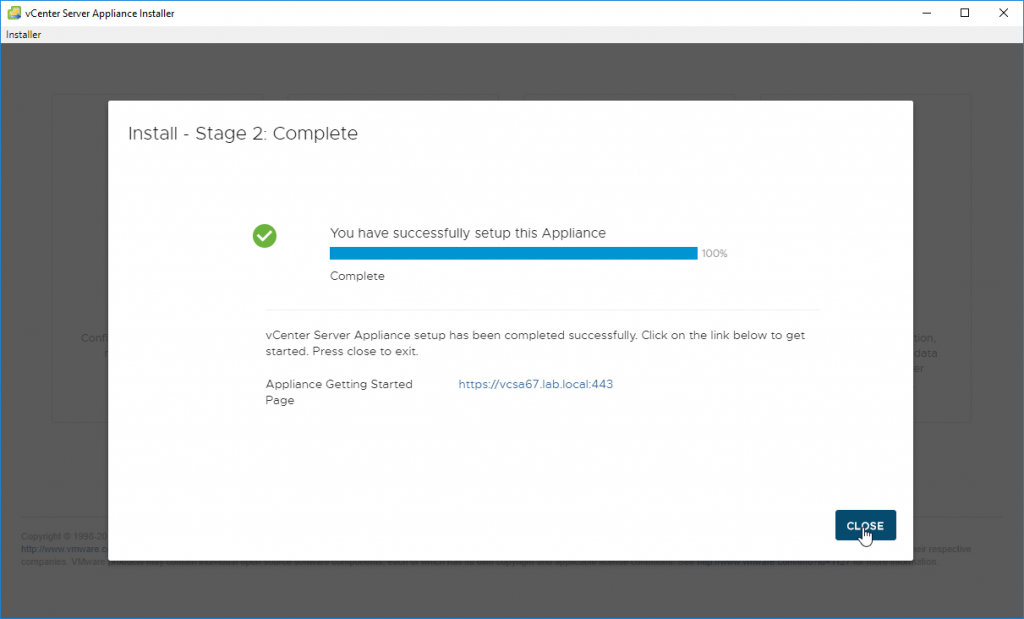
Stage 2 completed
And at the end you tin can launch either the HTML five web customer or the Flex based web customer. Both works, only the Flex based client will not be developed further.
VSAN from StarWind is software-defined storage (SDS) solution created with restricted budgets and maximum output in mind. It pulls close to 100% of IOPS from existing hardware, ensures high uptime and fault tolerance starting with just 2 nodes. StarWind VSAN is hypervisor and hardware agnostic, allowing you lot to forget about hardware restrictions and crazy expensive physical shared storage.
Build your infrastructure with off-the-shelf hardware, scale however yous like, increase return on investment (ROI) and relish Enterprise-course virtualization features and benefits at SMB toll today!
Post-Installation
Connect to the vCenter postal service install using the IP or FQDN of the vCenter. Y'all'll yet have a choice between HTML5 vSphere client and Flex based vSphere client. Yous'll accept 60 days to employ a license fundamental.
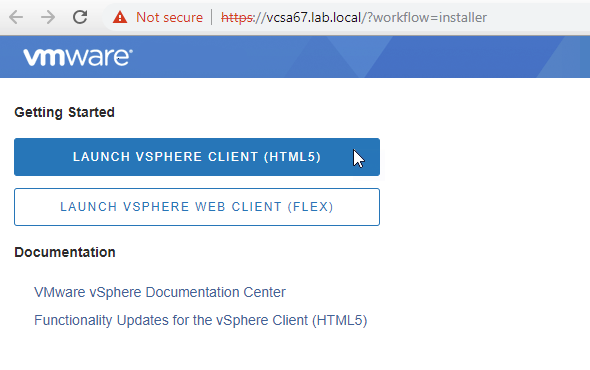
Launch vSphere HTML5 Web client
If information technology's a fresh deployment, and If yous take installed your hosts, you can now showtime to add them to your vCenter server.
Y'all would get-go by creating Datacenter object, cluster object and add host afterward host to the cluster.
Basically, this is the end of our post on Installing and configuring VMware vCenter Server Appliance (VCSA) 6.7 U1.
Even though it is a Linux appliance, the process is very straightforward and simple. VMware has washed a good job to keep things unproblematic.
By slowly eliminating any plugins (erstwhile Flash based client is going slowly abroad) and providing good and unproblematic workflows with form checks for password correction and network requirements, there is very few thins which could perhaps go incorrect.
- 5 Tips to Principal VMware vCenter Server Appliance
- 5 useful tips to work with VMware vCenter Server Appliance 6.5
DOWNLOAD HERE
Posted by: nevinsgisabloo.blogspot.com